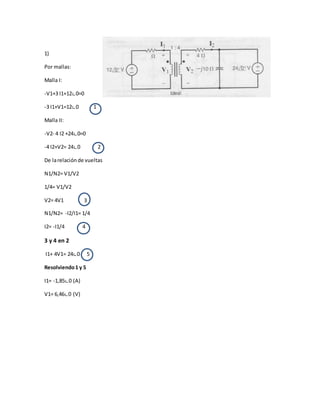
Unidad i act5_vasallo ricardo
- 1. 1) Por mallas: Malla I: -V1+3 I1+12∟0=0 -3 I1+V1=12∟0 1 Malla II: -V2- 4 I2 +24∟0=0 -4 I2+V2= 24∟0 2 De larelación de vueltas N1/N2= V1/V2 1/4= V1/V2 V2= 4V1 3 N1/N2= -I2/I1= 1/4 I2= -I1/4 4 3 y 4 en 2 I1+ 4V1= 24∟0 5 Resolviendo1 y 5 I1= -1,85∟0 (A) V1= 6,46∟0 (V)
- 2. De 4: I2= 1,85∟0A=0,46∟0 (A) 4 De 3: V2= 4(6,46∟0)(V)= 25,84∟0 (V) 2) Por mallas Malla I (2-J4+ 2J+ 3) I1-J I2-3 I2= 32∟0 (5-J2) I1 –(3+J) I2=32∟0 1 -(3+J) I1 +(3+J2+J2+3) I2=0 -(3+J) I1+(6 I2)=0 2 I1= 6 I1/3+J 3 Sustituimos3en1 ((5-J) 6 I2/3)+J – (3+J) I2= 32∟0 4 [((5-J) 6/3)+J– (3+J)] I2= 32∟0 [5,4-5,8J] I2= 32∟0 I2= 32∟0 (V) (5,4-5,8J) Ω I2= 4.04 ∟47,05 (A) Del circuitovemosque Io= I2 Io= 4,04∟75,05 (A)
- 3. 3) Por mallas Malla I (1-J) I1 – (-JI2)= 24∟0 (1-J) I1+ J I2= 24∟0 1 -(-JI1) + (3-J+ J2-J2+J2) I2 – J I2-JI2=0 J I1 + (3+J-2 J) I2=0 J I1 + (3-J) I2=0 I1= (-(-3-J)/J) I2 2 Sustituimos2en1 (1-j) [(-(3-j)/j)] I2+ J I2= 24∟0 [(1-J)(3-J) J+J] I2=24∟0 [4+3 J] I2= 24∟0 I2= ((24∟0)/(4+3 J)) (A) = (( 24∟0)/(5∟+36,87)) (A) I2= 4,8∟ -36,87 (A) De laLey de Ohm Vo= 3 I2 = 3(4,8∟ -36,87 (V) Vo= 14,4∟ -36,87 (V)
- 4. 4) De larelaciónde vueltas:a= 1/2=Z La impedancia reflejadaes: Zr=A2 Z2= (1/2)2 (4+4J)= (1+J) Ω El circuitoequivalentees: Zp= (-J(1+J)/(-J+1+J)=(1-J)Ω V1= ((10∟30)/(3+Zp))*Zp(Divisorde tensión) V1=((10∟30)/(3+1-J)) (1-J) V1= 3,43∟-0,96 (V) I1= V1/Zr + - -
- 5. I1= ((3,43∟0,96)/(1+J))=2,43∟ -45,96 (A) I1= 2,43∟ -45,96 (A) V1/V2=a V2=V1/a= ((3,43∟ -0,96)/(1/2)) V2= 6,86∟ -45,96 (V) I2= a I1= 1/2(2,43∟ -45,96) A I2= 1,22∟ -45,96 (A)
